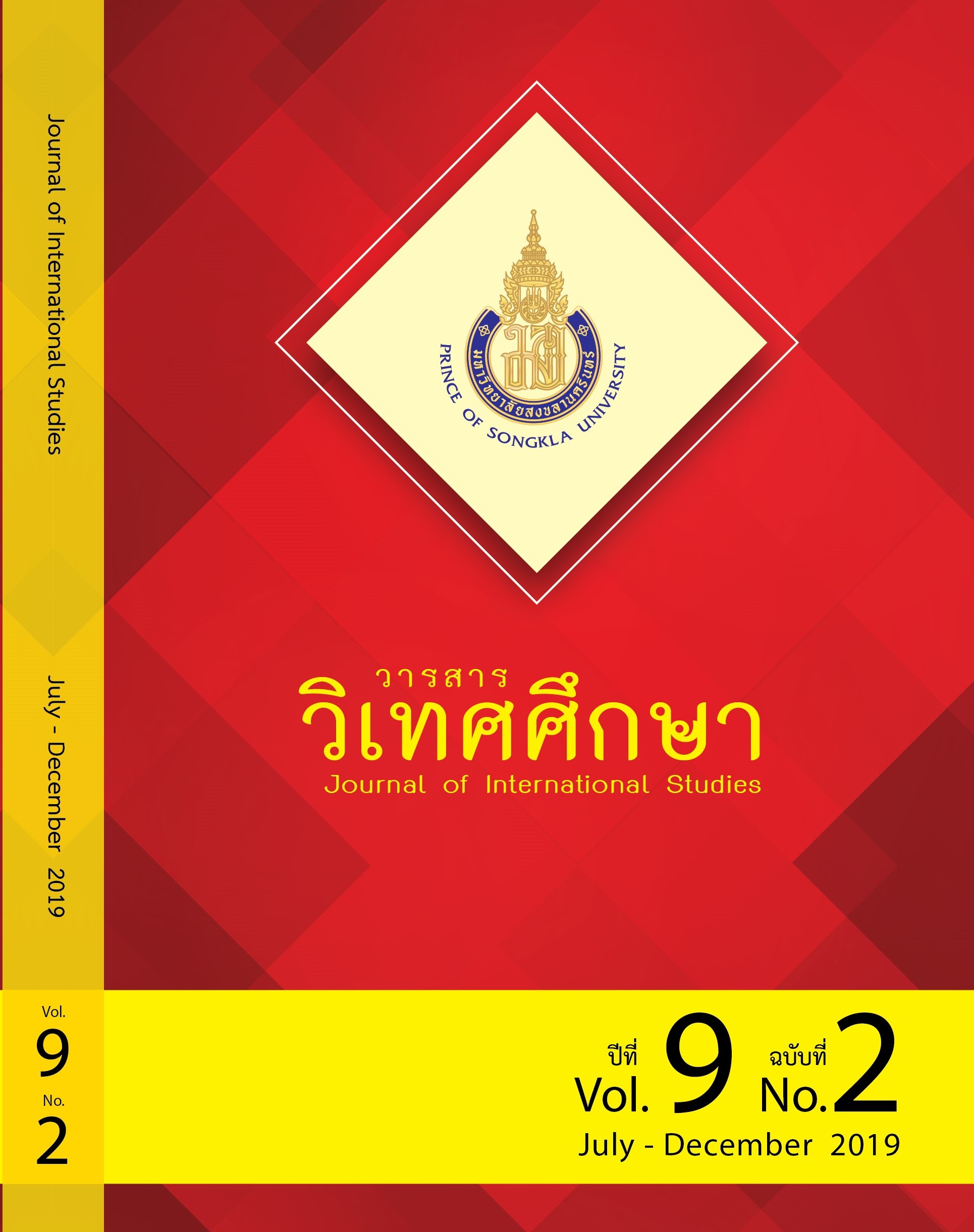การเรียนรู้ภาษาอังกฤษนอกชั้นเรียน และทักษะการสื่อสารของนักศึกษาระดับอุดมศึกษา
Main Article Content
บทคัดย่อ
งานศึกษานี้เป็นการศึกษาเชิงปริมาณและเชิงคุณภาพ โดยมีวัตถุประสงค์เพื่อ (1) ศึกษาผลของการเรียนรู้ภาษาอังกฤษนอกชั้นเรียนต่อทักษะการสื่อสารภาษาอังกฤษ (2) ศึกษาปัจจัยที่มีผลต่อการเรียนรู้ภาษาอังกฤษนอกชั้นเรียน เครื่องมือที่ใช้ในการศึกษาประกอบด้วย แบบสอบถาม แบบบันทึกการเรียนรู้ แบบทดสอบทักษะการสื่อสารก่อนและหลังการศึกษา การศึกษานี้จัดทำขึ้นในมหาวิทยาลัยแม่ฟ้าหลวง ซึ่งเป็นมหาวิทยาลัยในกำกับของรัฐที่ใช้ภาษาอังกฤษเป็นสื่อกลางในการเรียนการสอน กลุ่มตัวอย่างในการศึกษาครั้งนี้เป็นนักศึกษาชั้นปีที่ 3-4 ที่สมัครใจเข้าร่วมโครงการศึกษานี้ และศึกษาอยู่ในหลากหลายสาขาวิชา ในปีการศึกษา 2560 หลังจากการเข้าร่วมการเรียนรู้นอกชั้นเรียนเป็นเวลา 10 สัปดาห์แล้ว ผลการศึกษาพบว่าผู้เรียนที่มีทักษะการเรียนรู้ด้วยตนเอง มีคะแนนทดสอบหลังการเข้าร่วมกิจกรรมสูงกว่าคะแนนก่อนการทดสอบอย่างมีนัยสำคัญทางสถิติที่ระดับ .05 สำหรับปัจจัยที่เกี่ยวข้องกับทักษะการสื่อสารของผู้เรียน ได้แก่ ความสามารถด้านคำศัพท์และไวยากรณ์ภาษาอังกฤษ ส่วนปัจจัยที่มีผลต่อการเรียนรู้ภาษาอังกฤษนอกชั้นเรียน ได้แก่ แรงจูงใจในการเรียนและบริบทในการเรียนรู้ของผู้เรียน
Article Details
ข้อความและความคิดเห็นที่แสดงในบทความ เป็นแนวคิดของผู้เขียน มิใช่ความรับผิดชอบของกองบรรณาธิการ และคณะผู้จัดทำแต่อย่างใด
บทความ ข้อมูล เนื้อหา รูปภาพ ฯลฯ ที่ได้รับการตีพิมพ์ในวารสารวิเทศศึกษา ถือเป็นลิขสิทธิ์ของวารสารวิเทศศึกษา หากบุคคลหรือหน่วยงานใดต้องการนำทั้งหมดหรือส่วนหนึ่งส่วนใดไปเผยแพร่ต่อหรือเพื่อกระทำการใด ๆ จะต้องได้รับอนุญาตเป็นลายลักษณ์อักษรจากวารสารวิเทศศึกษา ก่อนเท่านั้น
เอกสารอ้างอิง
Benson, P. & Lor, W. (1999). Conceptions of language and language learning. System, 27(4), 459-472.
Champakaew, W. (2013). The Effectiveness of Negotiation of Meaning Strategies in Two-way Communication Tasks for Oral Proficiency and Grammatical Development of Higher Education Level Students. Dissertation, Graduate School, Chiang Mai University.
Chin-Yi, Chang, Shu-chen, Liu, and Yi-Nian, Lee (2007). “A Study of Language Learning Strategies Used by College EFL Learners in Taiwan.” Language Learning.
Cohen, A. D. & Macaro, E. (2007). Language Learner Strategies: Thirty Years of Research and Practice. Oxford: Oxford University Press.
Cortina-Pérez, B. & Solano-Tenorio, L. (2014). The effect of using out-of-class contexts on EFL learners: an action research. Calidoscópio, Vol. 11, n. 2, p. 167-177.
Ellis, R. 1994. The study of second language acquisition. Oxford: Oxford University Press.
Gass, S. and Selinker, L. (2008). Second Language Acquisition: An Introductory Course. New York: Routledge.
Hayes, D. (2008). Becoming a teacher of English in Thailand. Language Teaching Research. 12, 4; pp. 47-494.
Hedge, T. (2008). Teaching and Learning in the Language Classroom. Oxford: Oxford University Press.
Hughes, L., Krug, N., and Vye, S. (2011). The Growth of an Out-of-Class Learning Community through Autonomous Socialization at a Self-Access Center. SiSAL Journal. Vol. 2, No. 4, December 2011, 281- 291.
Hurd, S. (2006). Towards a Better Understanding of the Dynamic Role of the Distance Language Learner: Learner perceptions of personality, motivation, roles, and approaches. Distance Education. 27 (3). Retrieved May 11, 2016 from http://www.tandfonline.com/doi/ abs/ 10.1080/01587910600940406
Kampa, K. & Vilina, C. (2017). “Building 21st Century Skill in the Young Learners’ Classroom.” The Language Teacher, 41.6, November. Retrieved January 13, 2018 from http://jalt-publications.org/node/4988/ articles/23992-building-21st-century-skills-young-learners%E2%80%99-classroom-part-two.
Ko, J., Schallert, D. L. and Walters, K. (2003). “Rethinking Scaffolding: Examining Negotiation of Meaning in an ESL Storytelling Task.” TESOL Quarterly, Vol. 37, No. 2.
Krashen, S. D. (1976). Second Language Acquisition and Second Language Learning. Pergamon Press Inc.
Lightbown, P.M., Spada, N. (2006). How Second Languages are Learned. Third edition. Oxford: Oxford University Press.
Manfred, W. (2012). Beliefs and Out-of-class Language Learning of Chinese-speaking ESL Learners in Hong Kong. New Horizon in Education, Vol.60, No.1, May.
Maros, M. & Mat Saad, N. (2016). “The Out-of-class Language Learning Strategies of International Students in Malaysia.” International Journal of Social Sciences, 6(8), 478-486.
McKay, S. L. (2002). Teaching English as an International Language. Oxford University Press.
Oxford, R. (1999). Relationships Between Second Language Learning Strategies and Language Proficiency in the Context of Learner Autonomy and Self-regulation. evista Canaria de Estudios Ingleses, No. 38, pp. 109-126
Phitsuwan, S. (2012). ASEAN Charter: Challenges and Opportunities. Future Challenges toward ASEAN Integration. Electronic Proceeding: Mae Fah Luang University, 29 November-1 December. Retrieved May 14, 2016 from http://mfui c2012.mfu.ac.th/ electronic_ proceeding/1st%20MFUIC%202012%20ELECTRONIC%20PROCEEDING.html
Reinders, H. (2014). Personal Learning Environments for Supporting Out-of-Class Language Learning. English Teaching Forum, November 4.
Sakui, K. & Gaies, S.J. (1999). Investigating Japanese learners’ beliefs about language learning. [Special Issue]. System 27, 473-492.
Thanasoulas, D. (2000). “What is Learner Autonomy and How Can It Be Fostered?” The Internet TESL Journal, Vol. 6, No. 11. Retrieved May 14, 2016 from http://iteslj.org/Articles/Thanasoulas-Autonomy.html
Wiriyachitra, A. (2012). “English Language Teaching and Learning in Thailand in this Decade.” Thai TESOL Focus, 15(1), 4-9.


